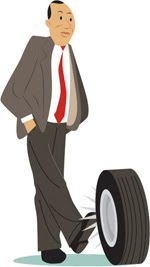
It is crutial to test drive a car. It is really important to be aware of what to look for when you are doing this. There are certain things you need to make a note of. In the image above we can see a new brake pad on the left and an old worn one on the right. Brake pads are the most common replacement part of your automobiles.
Go to an open space (empty car park or empty long road). From a speed of about 30mph come to a sudden stop. So, note what the car does. If it pulls to one side, or takes too long to fully stop, this could mean that the brakes need to be done.
Note how far down the brakes fo to the floor.Check the brake fluid. If the color is off or if it looks the same consistency as water, this is a warning sign that the brake system has not been serviced for a long time.
Brakes need to be replaced frequently on cars. Most cars have a wear indicator, is there a noise coming from the brake area when the brakes are used. (Be aware however that even if there is no noise this does not mean your brakes are ok, it could mean that the indicator has broken off).
Is the emergency brake weak?
When your driving the car, if the steering wheel shakes in your hands when you come to a stop, the rotors may need to be replaced.
Depending on different problems you can expect to pay a couple hundred pounds to replace brake pads, most of this is for labour, and it is a tricky job to do by yourself. Front disks and pads should cost around £180. Just be aware that this is an extra cost on top of what you are paying already.


